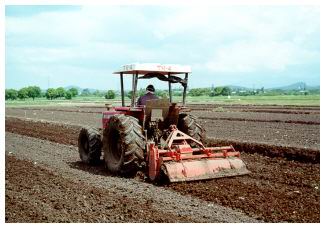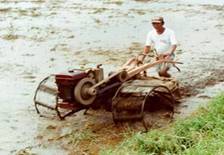|
|
|
Land preparation |
|
|
|
|
|
|
|
|
|
Types of tillage |
|
|
|
|
|
|
|
|
|
Describe primary and secondary tillage. |
|
|
|
|
Tillage is normally classified as primary or secondary tillage. While soil puddling can be classified as a secondary tillage its primary purpose is to restrict water movement from the surface layers. |
|
|
|
|
1. Primary tillage
Primary tillage is the first soil tillage after the last harvest. It is normally conducted when the soil is wet enough to allow plowing and strong enough to give reasonable levels of traction. This can be immediately after the crop harvest or at the beginning of the next wet season. When there is sufficient power available some soil types are ploughed dry.
The objectives of primary tillage are:
Ploughing with an animal (left) or a tractor with a one-way disc
The implement most commonly used with an animal powered system is the moldboard plows. In clay soils, the fields often have to be fully saturated before tillage can be undertaken. In lighter texture soils such as loam or sand, tillage can be undertaken at moisture levels below field capacity. In 2-wheel powered systems both moldboard and disc ploughs (one-way disc)are used. The disc is usually the preferred system as it takes less power and can handle obstacles much easier. In a 4-wheel tractor system, three-disc, seven-disc and offset ploughs are the most common. Tined plows are preferable in the upland systems but as yet not widely available in Asia.
|
primary tillage
|
|
|
|
2. Secondary tillage
Secondary tillage is any working completed after primary tillage and is undertaken for
Secondary workings are usually shallower and less aggressive than primary tillage. In the animal powered system, the second working is normally undertaken with the moldboard plough when the field is fully saturated. The final workings are then completed using peg tooth harrows to puddle the soil and leave the surface level and ready for planting. In 2-wheel tractor systems, the moldboard, the disc and the rotovator are used for second working. In some instances peg tooth harrows are also used if rotovators are not available. Cage wheels on the tractor are needed for traction in all soil types and these also help puddle the soil. In 4-wheel tractor systems, tined cultivators, seven-disc ploughs, offset disc ploughs and rotovators are the most commonly used equipment for second workings. In this system, fields are either mechanically puddled with tractors using a rotovator and leveling board or by tractors fitted with large cage wheels and harrows.
Normally 2-3 secondary workings are done after primary tillage and before planting but this will depend the cloddiness of the soil, the number of weeds, the need to incorporate fertilizer and the need for puddling. It is common in many countries for the first two workings to be undertaken using tractors and the final working done by animals and harrows.
Secondary tillage using a rotovator (left), harrowing operation (right)
Puddling is the working of the soil in a totally flooded state to realign soil particles in a manner that will reduce the water penetration and leave the surface level for crop establishment. It is normally done using tractors and rotovators or animals and peg tooth harrows.
Puddling by a 2-wheel tractor
|
secondary tillage |
|
|
|
3. How is upland tillage different?
Upland tillage is undertaken in locations where crops are grown in aerobic soil conditions. This means that the soils are non-puddled soils and there is no freestanding water in the fields.
Soil moisture levels are critical when ploughing in an upland-farming situation. If the soil is too dry it will not till easily, the power requirement will increase and in clay soils large clods may be formed. In clay soils these large clods may cause problems when trying to decrease ped size to create a seedbed. If the soil is ploughed very wet, near soil saturation, smearing and soil sealing can become problems during seedbed preparation.
Animal powered systems use a moldboard plough, while 2-wheel and 4-wheel tractor powered systems use one-way disc, offset disc and tined implements. These systems often require more tillage operations to control weeds. In low land systems weeds are often controlled by incorporation while in upland systems weeds are best cut and left on the surface to die.
Upland tillage
In these systems water erosion can be a problem and ploughing on the contour is recommended. |
|
|
|
|
|
|
Next lesson |
|
In the next lesson we will discuss the importance of plowing patterns, and show how it can be done. |
|








